|
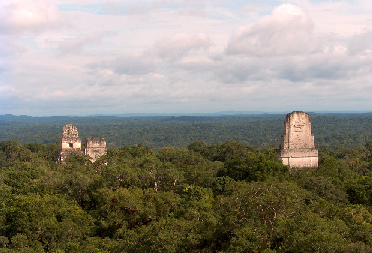
 Prehistoric Guatemala:
Prehistoric Guatemala:
Guatemala is a
nation with direct decadency to the old Mayan
civilization, and before them the Olmecs. The Mayan Ruins in
Guatemala are a living testimony to a culture that once flourished
between 700 BC to 900 AD. The most prominent Mayan Ruins can be
found in the Tikal area and across the Honduran border in Copan.
Smaller remains of Mayan buildings can be seen all over Guatemala.
Guatemala possesses
the largest pyramid in the world (by volume), and the earliest
evidence in the world of an understanding of the properties of magnetism.
Article:
(UniverseToday. May, 2012) - 'Mayan
Glyphs Refer to 17th B'ak'tun'.
A new archaeological discovery in the ruins of
Xultun has proved that the end of the 13th B'ak'tun
was neither considered the end of the calendar nor
the end of the world by the Mayans.
"It is very clear that the 2012 date, while
important as Baktun 13, was turning the page...
Baktun 14 was going to be coming and Baktun 15 and
Baktun 16...The Mayan calendar is going to keep
going and keep going for billions, trillions and
even octillion years into the future"
(Link
to Full Article) |
The Mirador Basin
in the far northern Pet�n region of Guatemala is known for its
abundance of sites, many of which are among the largest and earliest
in the Maya world. Of 26 known sites, only 14 have been studied; an
estimated 30 more await discovery. Since 2003, Global Heritage Fund
(GHF) has been working in Mirador to protect its priceless ancient
cities and monuments and preserve the site for future generations.
Led by project director Dr. Richard Hansen, founder and president of
the Foundation for Anthropological Research and Environmental
Studies (FARES), GHF has established a new 880,000-acre national
park in the area, and continues to work with local communities like
nearby Carmelita to ensure Mirador�s integrity and sustainability.
In 2010, after completion of site conservation, El Mirador opened to
the public for the first time.
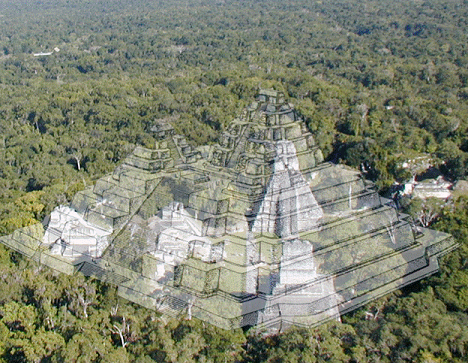
La Danta. The
largest pyramid in the world (by volume).
(More
about Mirador and La Danta)
The
recognition that magnetism was understood in
pre-Columbian Mesoamerica began with the discovery of a
flattened oblong piece of Haematite discovered in
southern Vera Cruz in 1966. In 1975 a basalt
sculpture (generally described as a Turtles head), at
the site of Ipaza was also found to possess a strong
magnetic field. This sculpture has a north-seeking pole
in its snout and a south-seeking pole at the back of his
head.(2)
Several
additional magnetic sculptures were found in the nearby Monte
Alto ruins in the early 1950's and date from sometime between
1400 and 400 B.C, a period of time which covers the emergence
and decline of the Olmec culture.
(1)
The magnetic
properties of the Democracia 'Fat-boys', as they are called
today follow certain rules. When an entire body is depicted, two
magnetic poles are usually found on either side of the navel;
when only a head is portrayed, the two magnetic poles are almost
invariably centred on the right temple. Other sculptures at El
Baul include a rampant jaguar, with magnetic poles in each
upraised paw, and a tablet showing two men seated on a bench
with their arms folded over their chests. This single block of
stone has four magnetic poles, one north-seeking pole between
each of the men's folded arms and one south-seeking pole below
each man in the space beneath the bench.
(3)
These
sculptures represent the oldest known magnetic artefacts in the
world. They pose two fairly substantial questions: First, we
must ask if their sculptors were actually aware of their
magnetic property, and, if so, how they might have initially
recognized it, especially in the presumed absence of iron. And
second, once the magnetic property of each of these stones was
known, what prompted their sculptors to associate this force
with such localized parts of the body as the right temple and
the navel?

One of Guatemala's
several famous 'Fat-boy' with its naturally magnetised navel and
temple.
(Other
Examples
of Magnetism in Prehistory)
The Guatemalan Stone
Heads.
There have been
several stone heads discovered in Guatemala. their origin is
relatively unknown although it is assumed that there was some
influence from the nearby Olmec culture from which we have 17
known carved stone heads. The facial characteristics between the
two cultures are noticeably different.

Photo from 1940's-1950s
of a vast stone head in the Guatemalan jungle. Sadly, it is
said that this head was destroyed in the process of removal.
This
photograph was apparently taken by the owner of the farm next to
Monte Alto, in Guatemala.

To date, 11 large
undated carved heads or rotund bodies with heads ("fat boys") have
been found in a cornfield near Monte Alto, the southmost
site. Malmstrom describes them as:
"... large
rounded boulders, often 1.5 m (5 ft) or more in diameter, were
selected as the medium upon which either the rudimentary features of
a head or a body were etched out in bas-relief. Only a minimal
amount of carving was done, so in all cases the faces have a
decidedly bloated appearance and the bodies are corpulent."
"The heads
that were depicted tended to have a fairly similar, generic
appearance. If they were intended to highlight any individual
differences, their sculptors appear to have been singularly
unsuccessful, although a few of the heads do have some strikingly
unique characteristics."
"The bodies,
on the other hand, almost invariably have the arms wrapped around
them so the fingers of the hands nearly come together over the
fullness of their abdomens, and the legs and feet often do a similar
encircling act near the base of the sculpture."
Image right: Stone head ("Monument 1") from
Monte Alto, Guatemala. After Michael Coe, The Maya
(2005).

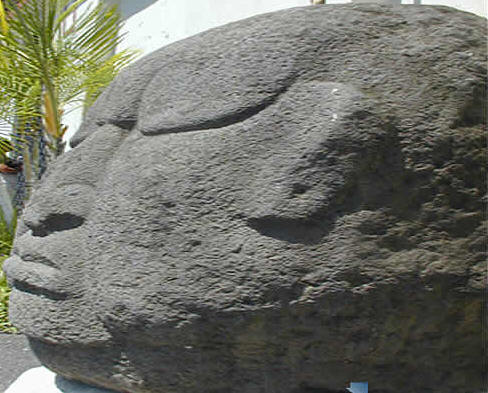
Monte Alto Stone
Head, Front and Side.
(The
Olmec Stone Heads, Mexico)

Argentinean
Stone-Heads:
This recently
discovered stone head was found in the waters of Lake Traful, in
Patagonia, Argentina. The Lake is the starting point of the
Traful River that empties into the Nahuel Huapi Lake. At Present
nothing more is known about it.
Photo Copyright:
http://www.arqueologicas.com.ar/
Another Image is
available here:
http://www.underwaterphotography.com
|
The Cult of the Mushroom:
|

Psychedelic mushrooms were called the 'Holy Children'
by the Mazatec shamen.
The late
Maya archaeologist Dr. Stephan F. de
Borhegyi, was convinced that
hallucinogenic mushroom rituals were a
central aspect of Maya religion. He
based this theory on his identification
of a mushroom stone cult that came into
existence in the Guatemala Highlands and
Pacific coastal area around 1000 B.C.
along with a trophy head cult associated
with the Mesoamerican ballgame. In most
cases the mushroom imagery
was associated with ritual sacrifice
in the Underworld, with jaguar
transformation and calendar period
endings, and with the decapitation and
resurrection of the underworld Sun God
by a pair of deities associated with the
planet Venus. Mushrooms were also
closely associated with Tlaloc and the
ritual warfare carried out in his name
that is known as Tlaloc warfare.
Link to Full
Article:
http://mayavasepro.webs.com/
 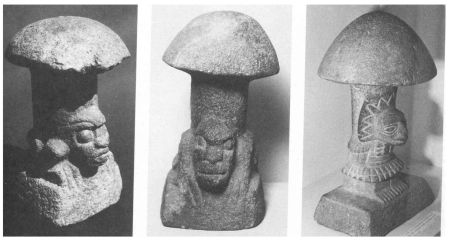 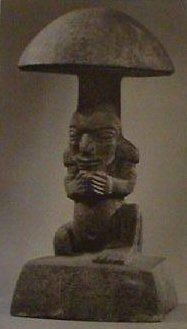
Samples from
the cache of ten mushroom figurines
discovered in Guatemala city and
dated at around 100 - 300 BC.
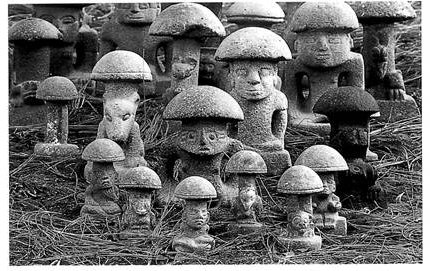
More of the estimated 200
mushroom stones that escaped destruction despite the
concerted efforts of Catholic missionaries. The
smaller stones are the ones found with metates,
which were presumably used for grinding the
sacraments prior to use (Borhegi 1961)
(More
about the Role of Drugs in Prehistory)
 Tikal: Tikal:
Located in the Northern Guatemala region
of El Peten lies the Mayan city of Tikal.
It contains thousands of structures
extending over six square miles. Royal
palaces, temples, ceremonial platforms
and ball courts are all present here.
The city was founded during the Late
Pre-Classic Period (400 BC � 300 AD).
Most of the monuments seen today stems
from the reign of a ruler called Ah
Cacaw who came to power in 682 AD. Many
people consider Tikal to be the most
famous Mayan site ever built.
(Pre-Columbian Americas
Homepage)
(A-Z
Pages)
|
 Tikal:
Tikal:











